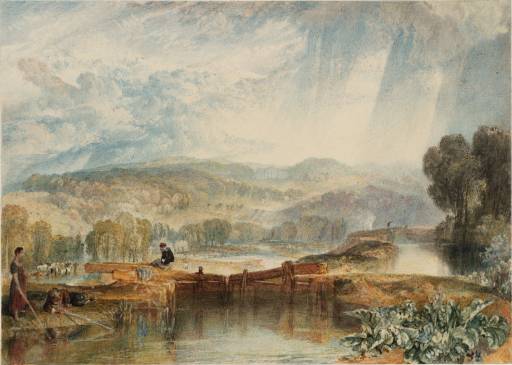Joseph Mallord William Turner More Park, near Watford, on the River Colne c.1823
Joseph Mallord William Turner,
More Park, near Watford, on the River Colne
c.1823
Joseph Mallord William Turner 1775–1851
More Park, near Watford, on the River Colne c.1823
D18141
Turner Bequest CCVIII H
Turner Bequest CCVIII H
Gouache and watercolour on white wove watercolour paper, 158 x 221 mm
Blind-stamped with Turner Bequest monogram bottom left
Blind-stamped with Turner Bequest monogram bottom left
Accepted by the nation as part of the Turner Bequest 1856
Exhibition history
1904
National Gallery, London, various dates to at least 1904 (168).
1969
Royal Academy Draughtsmen 1769–1969, British Museum, London, June–September 1969 (314).
1970
Turner: Watercolours Lent by the British Museum, Musée Provisoire d’Art Moderne, Brussels, November 1970–January 1971 (24).
1972
La Peinture romantique anglaise et les Préraphaélites, Petit Palais, Paris, January–April 1972 (293).
1974
Turner 1775–1851, Royal Academy, London, November 1974–March 1975 (240).
1975
Turner 1775–1851: zhivopis’, risunok, akvarel’, Hermitage Museum, Leningrad, October–November 1975, Pushkin Museum, Moscow, December 1975–January 1976 (21).
1976
J.M.W. Turner 1775–1851: Akvareller og Tegninger fra British Museum, Statens Museum for Kunst, Copenhagen, February–May 1976 (25).
1976
William Turner und die Landschaft seiner Zeit, Hamburger Kunsthalle, May–July 1976 (47 reproduced as Der More-Park bei Watford, am Colne-Fluß).
1978
¿¿¿¿¿¿, Shipka Gallery, Sofia, Bulgaria, April[–?May] 1978, Belgrade, Serbia [former Yugoslavia], May 1978, Muzeul de Arte al RS [Republica Socialista] Romania, Bucharest, June–July 1978 (23, as ‘CCVIII–¿’, reproduced p.[21]’).
1980
Turner at the Bankside Gallery: Drawings & Water-colours of British River Scenes from the British Museum, Bankside Gallery, London, November–December 1980 (54).
1981
J.M.W. Turner (1775–1851) / ¿¿.¿.G. ¿e¿¿e¿ (1775–1851), National Pinakothiki, Athens, January–March 1981 (20).
1989
Colour into Line: Turner and the Art of Engraving, Tate Gallery, London, October 1989–January 1990 (41).
1997
J.M.W. Turner 1775–1851: A Tate Gallery Collection Exhibition, Yokohama Museum of Art, June–August 1997, Fukuoka Art Museum, September–October 1997, Nagoya City Art Museum, October–December 1997 (43, reproduced in colour).
1997
Joseph Mallord William Turner, Bank Austria Kunstforum, Vienna, March–June 1997 (51, reproduced in colour).
2001
William Turner: Licht und Farbe, Museum Folkwang, Essen, September 2001–January 2002, Kunsthaus Zürich, February–May 2002 (83, reproduced in colour).
2008
Tëp¿ep [Turner] (1775–1851), Pushkin Museum of Art, Moscow, November 2008–February 2009 (49).
2009
Turner from the Tate Collection, National Art Museum of China, Beijing, April–July 2009 (49).
References
1904
E.T. Cook and Alexander Wedderburn (eds.), Library Edition: The Works of John Ruskin: Volume XIII: Turner: The Harbours of England; Catalogues and Notes, London 1904, p.615, no.168, as ‘The Colne. More Park’.
1909
A.J. Finberg, A Complete Inventory of the Drawings of the Turner Bequest, London 1909, vol.II, p.629, CCVIII H, as ‘More Park, near Watford, on the River Colne’.
1989
Anne Lyles and Diane Perkins, Colour into Line: Turner and the Art of Engraving, exhibition catalogue, Tate Gallery, London 1989, p.54 under cat. no. 42.
1990
Eric Shanes, Turner’s England 1810–38, London 1990, p.104, no.79 (colour).
A pencil sketch, inscribed ‘More Park’ or ‘For More Park’, was presumably used as a basis for this watercolour drawing and occurs in the River sketchbook of about 1807 (Tate D06071; Turner Bequest XCVI 76). It is also suggested that the study of foliage on folio 2 of the same sketchbook is related to that in the lower right-hand corner of the watercolour drawing (Tate D05962; Turner Bequest XCVI 2).
Eric Shanes writes that the More Park estate was ‘enclosed by Henry VI in 1426’. The ‘house itself was built during the reign of Edward IV by George Nevil and was owned at one time by Cardinal Wolsey’.1 In the centre, atop the crest of the hills in the distance, the entrance façade of house with its four-column portico comes faintly into view. The building owed its appearance to James Thornhill, better known for his work as a decorative painter. The owner of the house, the wealthy South Sea Company merchant Benjamin Styles, commissioned Thornhill to remodel it in a Palladian style, engaging Capability Brown to landscape the grounds.2
The body of water in the foreground is the Grand Union Canal at Lot Mead Lock, the Colne river flowing behind and beyond the Lock gates. There is a rough pencil jotting of the Lock in Turner’s River sketchbook of about 1807 (Tate D06020; Turner Bequest XCVI 49). The shallow ‘V’ shape made by the wooden lock, Eric Shanes notes, is recreated in the shapes of the sloping hills above it.3 A recumbent man and woman extend their fishing rods lethargically into the waters at the far left of the foreground. A solitary figure, perhaps the lock-keeper, perches atop the wooded lock with his back turned away from the viewer looking towards a small herd of cattle.
Anne Lyles writes that the drawing displays ‘Turner’s mastery of atmospheric effect’: the shafts of light which burst through rain-heavy grey cloud, the simulation of dampness in the air following rainfall.4 This point is elaborated on by Shanes who writes that ‘as a result of the downpour, the forms of the faraway trees are still slightly blurred by atmospheric moisture, whereas the trees on the extreme right and the dock leaves in the foreground are all crystal clear’.5
As with all the drawings in this series, pigment is applied with a meticulous stippling and hatching technique to produce a layered and richly textured prismatic effect.
More Park was engraved by Charles Turner in 1824 and was plate number four in the Rivers of England series (Tate impressions T04794–T04795).6
Verso:
Stamped in black with Turner Bequest monogram at centre and with ‘CCVIII H’ at centre towards top.
Alice Rylance-Watson
March 2013
How to cite
Alice Rylance-Watson, ‘More Park, near Watford, on the River Colne c.1823 by Joseph Mallord William Turner’, catalogue entry, March 2013, in David Blayney Brown (ed.), J.M.W. Turner: Sketchbooks, Drawings and Watercolours, Tate Research Publication, August 2014, https://www

